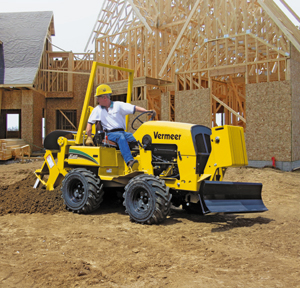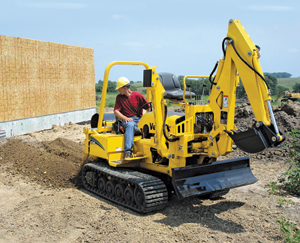Squeeze Play
Since first introduced more than half a century ago, compact ride-on trenchers have become the shining star among equipment fleets of landscapers, irrigation installers and utility contractors. If a contractor doesn’t actually own one, it’s a safe bet that access is just a phone call or rental center visit away.
Known primarily for their ability to squeeze into tight, confined spaces, compact ride-on trenchers have carved various niches with their many attractive features and benefits. Jobs that used to involve a spade and lots of sweat can now be completed in a fraction of the time, thanks to the reliable, maneuverable and versatile compact trencher.

Manufacturers have responded to customer feedback by developing models that are not only compact in frame, but pack enough power to complete a variety of jobs in varying soil conditions — without leaving barely a clue that a machine had once been onsite. Ride-ons have been a godsend for installing irrigation systems, transforming what once was a backbreaking chore into an efficient, streamlined process. Utility contractors use compact trenchers to connect any variety of services from a main trunk to a home or business. And compact trenchers have become a staple among rental equipment fleets, outnumbering other machines nearly 2 to 1.
Attractive Attributes
Although a compact ride-on trencher category has not officially been defined, the machines are most often classified by tractor horsepower and width of frame. Machine weight also plays a role, but industry experts concur that what matters more than total weight is the impact, or “footprint,” the machines make on a jobsite.
“There are several options for controlling footprint,” Kuyers says. “Trenchers outfitted with tracks exert the least amount of pressure, but there are also options for machines with tires. The goal is to inflict as little damage as possible to turf and sensitive landscapes.”
Although opinions may vary somewhat, most manufacturers would likely concur that as a category, compact ride-on trenchers would be defined as tractors under 50 hp, less than 72 in. wide and generally under 10,000 lbs total machine weight (including attachment). Trenching widths and depths for compact ride-on trenchers most commonly range from 2 to 12 in. wide, to a maximum of 5 ft in depth — ideally suited for shallow- to medium-depth installations.
These machines are more portable and, with the use of different attachments, often more versatile than their larger conventional trencher counterparts. Their overall weight also makes impact to sensitive jobsites less destructive.
Performance in a Small Footprint
Compact ride-on trenchers have legitimate claim to many attractive features and benefits — most notably, the ability to maneuver effectively in and around confined spaces. They can fit through most gates and into tight spots, making them ideal for residential landscapes that are crowded with obstacles.
Engineers consider weight, size, steering angles, turning radius and overall ease of operation when designing compact trencher models. Performance and operator safety are also major factors. Weight varies with the size of the model, but impact on turf can be controlled through several options. Rubber tracks exert minimal pressure. However, some wheeled units can be fitted with large flotation tires that exert pressures as low as 2.5 psi. By comparison, the feet of an average adult exert 6 to 8 psi when standing on turf.
Hydrostatic drive ranks among the most significant features, allowing operators to maximize production efficiency with minimal operator effort. Hydrostatic-driven machines also require less maintenance due to fewer moving parts.
“The trend for our customers is to go with hydrostatic,” Kuyers says. “There is a lot less maintenance, and hydrostatic has the ability to improve productivity. While these machines are very efficient, it’s important to remember that the performance of all trenching units, regardless of size and horsepower, will depend on soil type and the amount of debris encountered.”
The low center of gravity common with most compact trenchers, especially models outfitted with dual tracks, helps provide a more stable platform for operators and has allowed contractors to tackle more installations on steep, rugged slopes. In addition to all of the engineering enhancements developed to maximize production efficiency engineers have also focused on operator safety and comfort. Features such as operator presence systems, which automatically shut down trencher and ground drives when the operator leaves the seat, and advances in ergonomic design have helped lessen operator fatigue and increased productivity. Padded seats that can be adjusted for height and position relative to steering help reduce tension and back stress.
Attachments Abound

Irrigation contractors will always have use for the conventional chain trencher, but other types of equipment may be more efficient and better-suited for irrigation installations given different job sites. For example, a vibratory plow may be a better option for installing systems in established turf where a less invasive method is just as efficient and requires no backfilling.
Buying Tips
As with any equipment purchase, the right trenching unit for your operation is one that can be economically justified and meets your needs. Choosing the right trencher involves several important considerations, and equipment buyers should consider several factors:
1. Needs — Before making an equipment-purchasing decision, evaluate limitations. Look at the terrain, common obstacles, local ordinances and typical jobsites that you are most likely to encounter.
2. Trial Run — Call dealers representing several manufacturers and ask for an equipment demonstration on a jobsite where you are working. This will give you an opportunity to test equipment under real-world circumstances and compare models.
3. Types of Installations — Carefully analyzing how equipment will be used enables a realistic decision about model selection. Consider the type and size of products most often installed (irrigation, pipe, cable, etc.), the types of soils most often encountered, frequency of use (every day vs. occasionally) and attachments that can increase productivity and reduce labor.
4. Ease of Operation — The easier a trencher is to use, the more efficient and productive it will be. This is especially true for rental stores. Machine functions should be easy to explain and understand and controls clearly identified and arranged for easy, natural operation.
5. Maintenance — The easier it is to maintain a machine, the less likely regular service will be neglected. Check machine design for access and ease of routine maintenance and repairs. Look for models with extended maintenance periods, fewer daily maintenance points and features that make the trencher simple to maintain and repair.
6. Product Support — Timely access to parts and availability of professional service when repairs become necessary are also considerations for new equipment purchases. Warranties are extremely important. Have your dealer or sales rep thoroughly explain what is covered and what’s not … and how long the coverage lasts. Consider the manufacturer’s reputation and their dealer support network. This is especially important if you perform jobs in several states where access to your “home” dealer may not be convenient.
Prices for ride-on trenchers will vary from the mid-$30,000 to upper-$70,000 range, depending on model size, horsepower, attachments and addition of nonstandard features.
Randy Happel is a technical writer for Two Rivers Marketing Group, based in Des Moines, Iowa.






Comments are closed here.